[This is the second review in my “Three Winter Omakase” series. Winter Omakase at Shunji was the first. Winter Lunch Omakase at Kiriko will be the third.]
I had to travel to the Washington, D.C. area last month for work, I knew I wanted to try the best sushi that D.C. had to offer, to see how it compared to the great sushi we have here in L.A. I found several contenders, but the two that I narrowed it down to were Kaz Sushi Bistro and Sushi Taro. Each was within walking distance of the Farragut West metro station, with Kaz a mere two blocks away from the stop, but in the end Sushi Taro’s “Omakase Counter” intrigued me more. I sent an email to make a reservation, received a response the following day from co-owner Jin Yamazaki, called with my credit card to secure my reservation, and was set to have my first real high-end omakase on the East Coast!
I arrived 10 minutes before 7 PM on a Tuesday evening, having worked up an appetite from walking half a mile from the metro stop. The hostess informed me that they would be ready to seat me at the omakase counter in a few minutes, and I was shown to one of the regular dining tables with a glass of water to wait. I was pleasantly surprised to see the restaurant relatively full for an early weeknight. One thing I noticed was the absence of a sushi bar in the main dining area. Apparently, the only way to get a sushi bar experience was at the omakase counter.
Eventually I was brought around to the back of the main dining room, behind a divider, and into an intimate little space with an unidirectional counter (no L-shaped bar here) with only six seats, behind (in front of?) which was what I would describe as almost an entertainment kitchen. By that, I mean a space that would allow a chef to both make food and easily interact with their guests. A cooking-show-ready kitchen, with stainless steel and black marble, if you will.

I was greeted by executive chef Masa Kitayama, who would essentially be my personal chef during my meal, as co-owner/chef Nobu Yamazaki would be serving the only other party at the counter this evening, a man and a woman, who may or may not have been romantically involved–despite our physical proximity in the intimate space, I tried not to eavesdrop on their personal conversation, plus I was busy entering notes into my phone on my meal as it progressed, but over the course of the evening I did pick up that the man was a regular at Sushi Taro.
Masa-san inquired as to my beverage preference, and I opted for the Drinker’s Flight, which consists of 2oz servings of three different sake: Dassai 50, Oze no Yukidoke, and Tengumai.

While I enjoyed the sake over the course of the first hour of my meal, I’ll quickly recap my impression of each together. The Dassai 50 had a mild a sweet flavor, and was very smooth going down. The Oze no Yukidoke had a bit more bite. The tengumai was a little milder than the Oze no Yukidoke, but had a nice after-bite. If you couldn’t tell, I am no sake connoisseur, but I am definitely acquiring a taste for different sake.
The first course of the night was a goma (sesame) tofu, made with sesame seeds, toasted over charcoal and topped with fermented soybeans and fresh wasabi, resting in a sauce made with miso and a root starch (my notes say “yubu root” but I don’t think that’s correct).

The grill gave the tofu skin a light, crunchy texture that contrasted nicely with the creamy interior. The natural nuttiness of the sesame, combined with the miso, gave it a kind of Thai peanut sauce vibe, and was very tasty!
The second course was a suzuki kabura mushi, steamed branzini with grated turnip, with yuzu zest and gingko nuts.
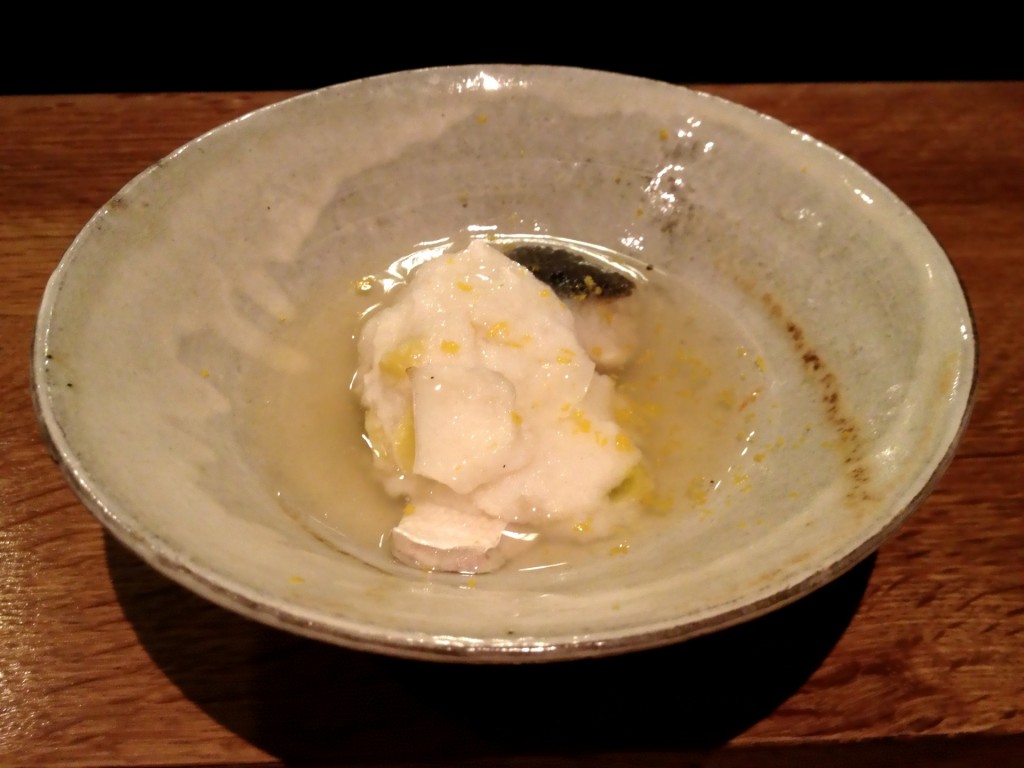
The yuzu zest and gingko gave small bursts of citrus and bitterness, respectively, but overall this was a mild dish, both in flavor and texture.
I was very excited about the next course, kegani, hairy crab from Hokkaido! I was served a few segments of kegani legs, simply steamed, with a wedge of lemon.
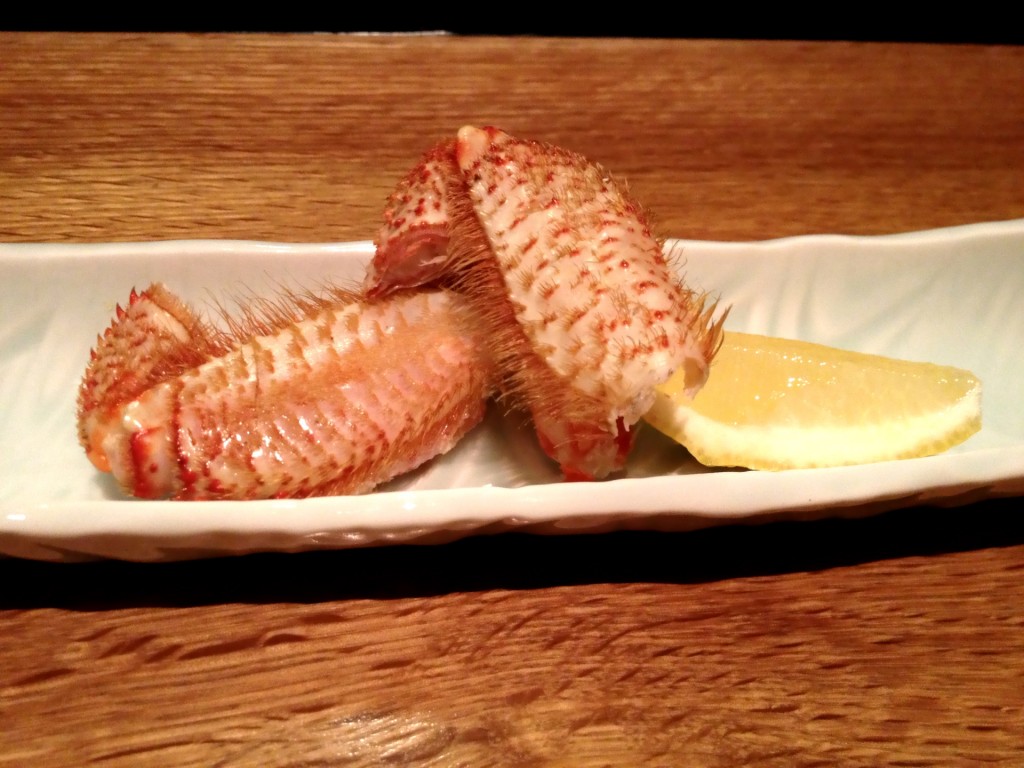
This was the first time I had kegani. It had a sweeter taste than snow crab and king crab, and had a “flakier’ texture. Of course, I had to ask if they had kani miso (crab innards). Nobu-san said the kanu miso wasn’t spectacular this year, but still gave me a dollop from.
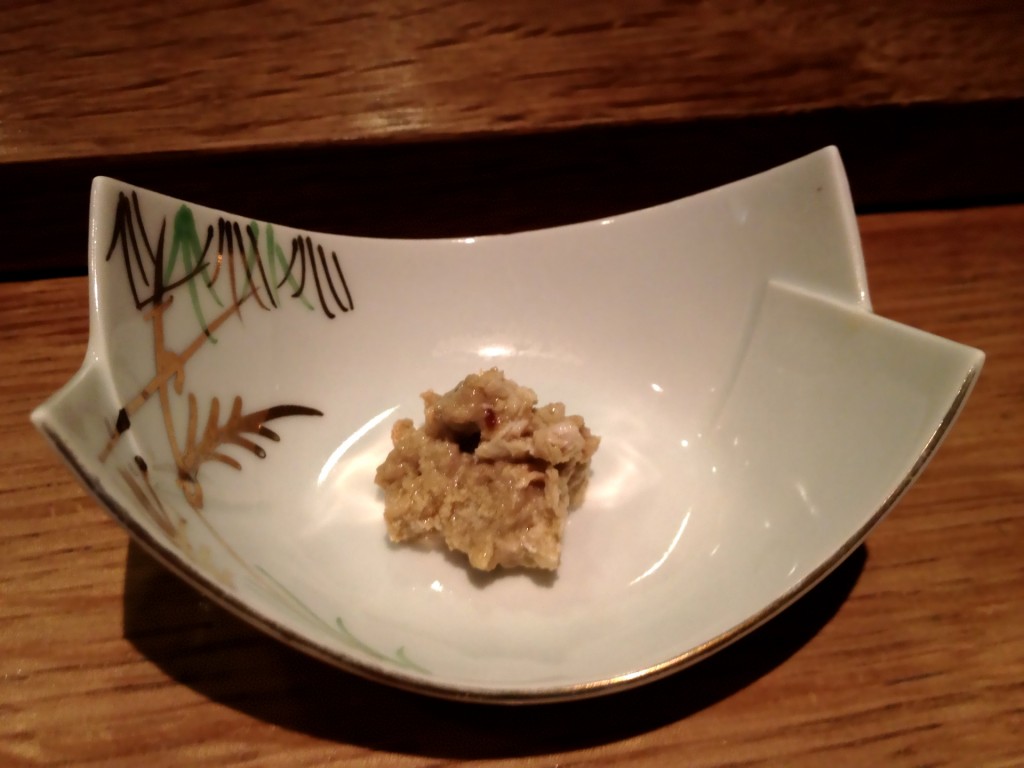
To the discerning palate of chef Nobu, the kani miso may not have been spectacular, but it tasted pretty darn good to me. It actually tasted more like lobster tomalley than the crab “mustard” that I’m used to.
The next course was the hassun, what would be the second course in a traditional kaiseki menu. It consisted of aoyagi mentai ae (orange clam and spicy pollock roe) in a small bowl, a tamagoyaki (egg omelet) roll, an ankimo (monkfish liver) terrine with ponzu gelee, nori-wrapped house mochi , gingko nuts stuffed with fish cake and rice cracker, karasumi (salted mullet roe) sandwiched between sliced daikon, snapper and ume (pickled Japanese plum) terrine, steamed kumquat, and sanma kobumaki (king mackerel wrapped in kombu).

It was an interesting and delicious assortment of tastes and textures. The tamagoyaki was light and spongy, while the nori/mochi was like a sticky and savory s’more. The terrines and stewed sanma were deep and rich, while the kumquat was a great palate cleanser. Karasumi has always been a personal favorite, so I saved it for last, and I savored it with a few sips of sake.
Masa-san indicated that it was time for the sashimi course. In a novel (to me) presentation, Masa showed me the various fish and other fresh ingredients that were available that night in six black lacquer boxes. The first contained amaebi (sweet shrimp), ikura (salmon roe), and two varieties of uni (sea urchin), one from Maine and one from Santa Barbara.

The second box contained an assortment of hikarimono (shiny-skinned fish), including aji (horse mackerel), ebodai (butterfish), kohada (gizzard shad), saba (Atlantic mackerel), and tobiuo (flying fish).

The third box contained kuruma ebi (wheel shrimp), hamaguri (common orient clam), ankimo (monkfish liver), tako (octopus), anago (sea eel), and tamagoyaki (grilled egg omelet).

The fourth box had hokkai masu (arctic char), New Zealand king salmon, tennen buri (premium wild yellowtail), and a fish that isn’t in my notes.
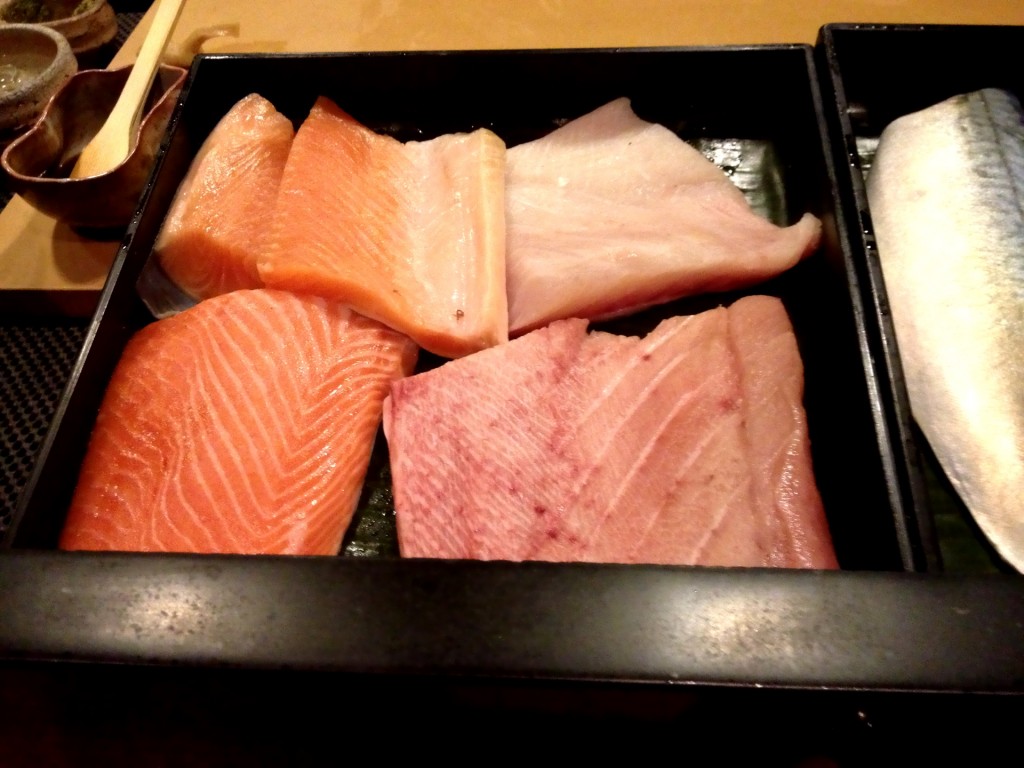
The fifth and sixth boxes I did not take pictures of. One contained the various cuts of tuna, including hon maguro akami (lean bluefin tuna), chu-toro (medium-fatty tuna), and toro (fatty tuna). The other contained varieties of shiromi no sakana (white fish), including itoyori dai (golden threadfin bream) and mana-gatsuo (Japanese pompano).
Masa-san asked whether I had any special requests or if I wanted to leave it up to him. I decided to trust my itamae, and he started me off with ebiko (shrimp roe).

The roe was briny and a little bitter, but quite delicate, without the crunchy pop of tobiko (flying fish roe).
Next was the amaebi (sweet shrimp) that the ebiko came from.
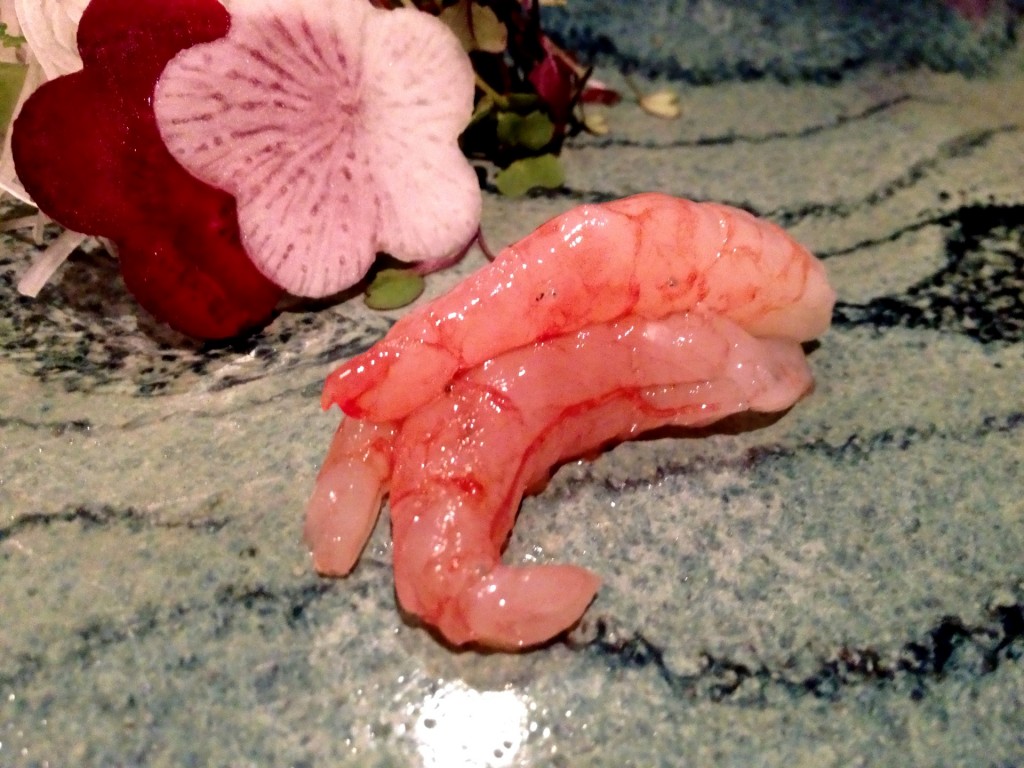
Unlike the amaebi I’m used to being served in L.A., which are generally larger in size and have a firmer consistency, these sweet shrimp were a bit softer, maybe a little sweeter, but quite delicious.
This was followed by a shiromi dane that I had not had before, itoyori dai (golden threadfin bream). The fish was simply dressed with some sea salt and was very similar to tai (red snapper).
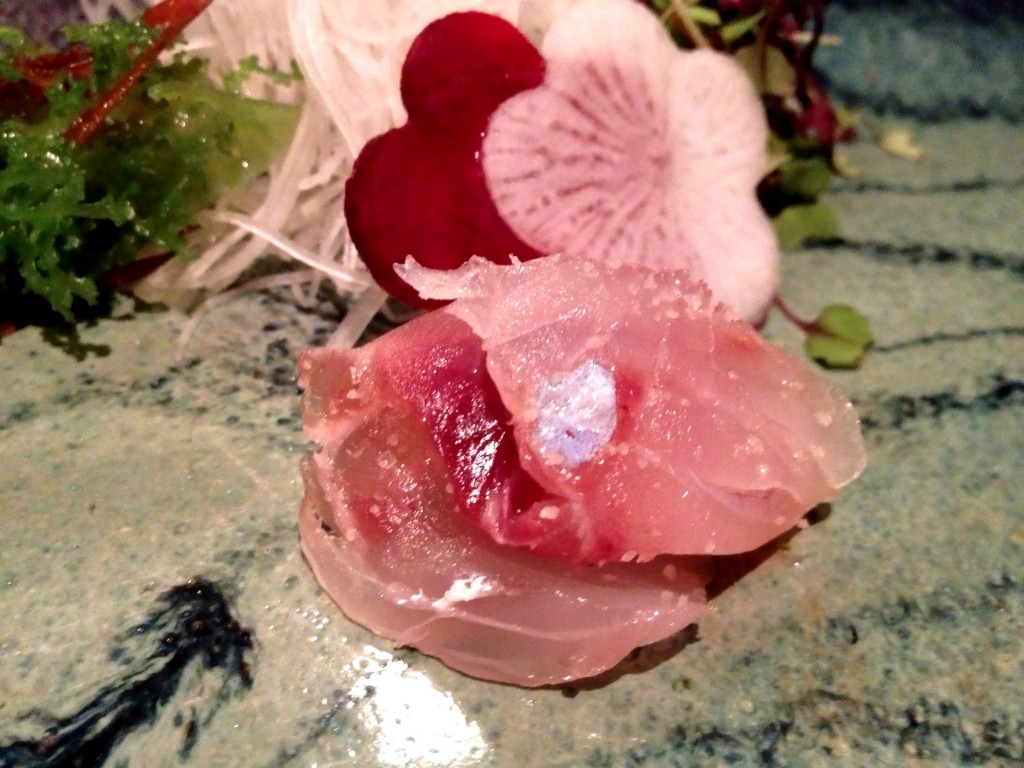
Another white fish, mana-gatsuo (Japanese pompano), was served next. It reminded me of hirame (halibut).

Next, Masa-san served up the fried heads of the amaebi along with some marinated ebodai (butterfish). The heads were rich yet crisp, and the ebodai reminded me a bit of marinated saba.

Next was tobiuo (flying fish) topped with asatsuki (garlic chive) and ginger, which I had with some ginger soy; Delicious!
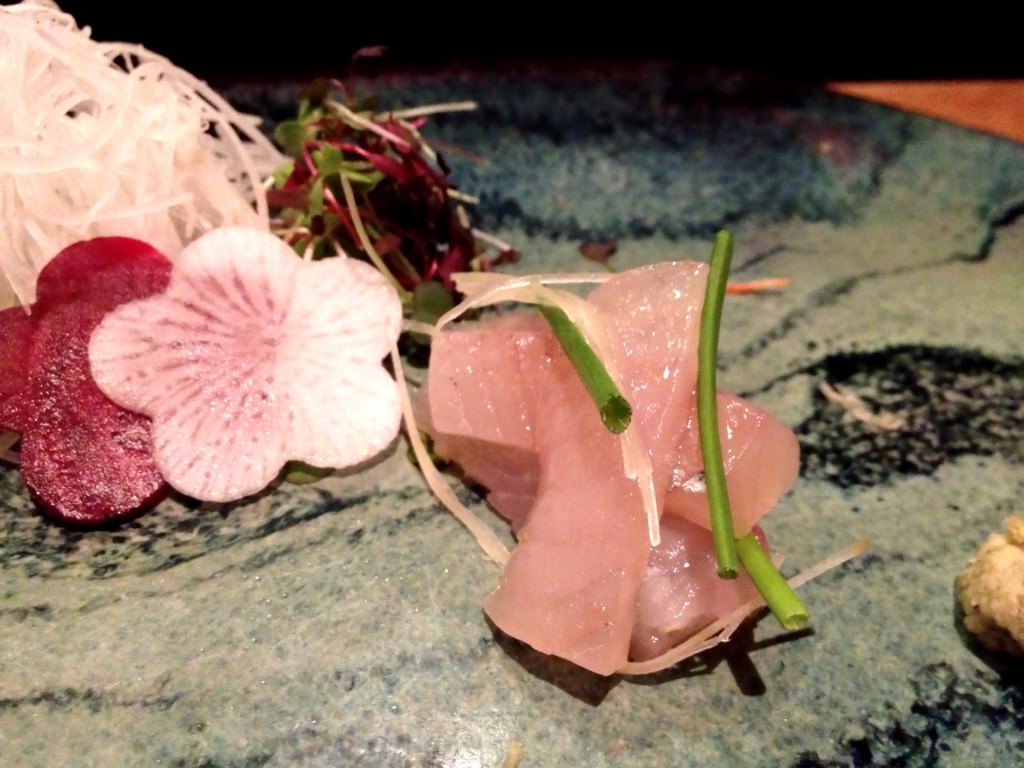
Masa-san served aji (horse mackerel) next that was prepared tataki. I had thought tataki meant seared, as the sushi/sashimi most commonly prepared tataki-style (in my experience) is albacore, which is generally seared. I guess tataki actually referred to the fish being sliced thin or chopped and then marinated in vinegar and seasoned with ground ginger.

Masa clarified that he was making it more like namero, almost tartare-like, in order to preserve the natural texture of the aji. At the time, all I knew was that it was delicious, but in researching tataki and namero, I am a little confused as the examples of namero I’ve found all have the fish more finely minced than tataki, which would be less likely to preserve the natural texture of the fish. Regardless, it was damn tasty!
Next was my favorite bivalve mollusk, hotate (scallop)! The shellfish was live, in its iconically-shaped shell, moments before it was dispatched and served to me topped with sea salt. The texture was much creamier than the hotate I’m used to, but it was from the Northeast, whereas the hotate I’ve had back home are I’m pretty sure from the West Coast.
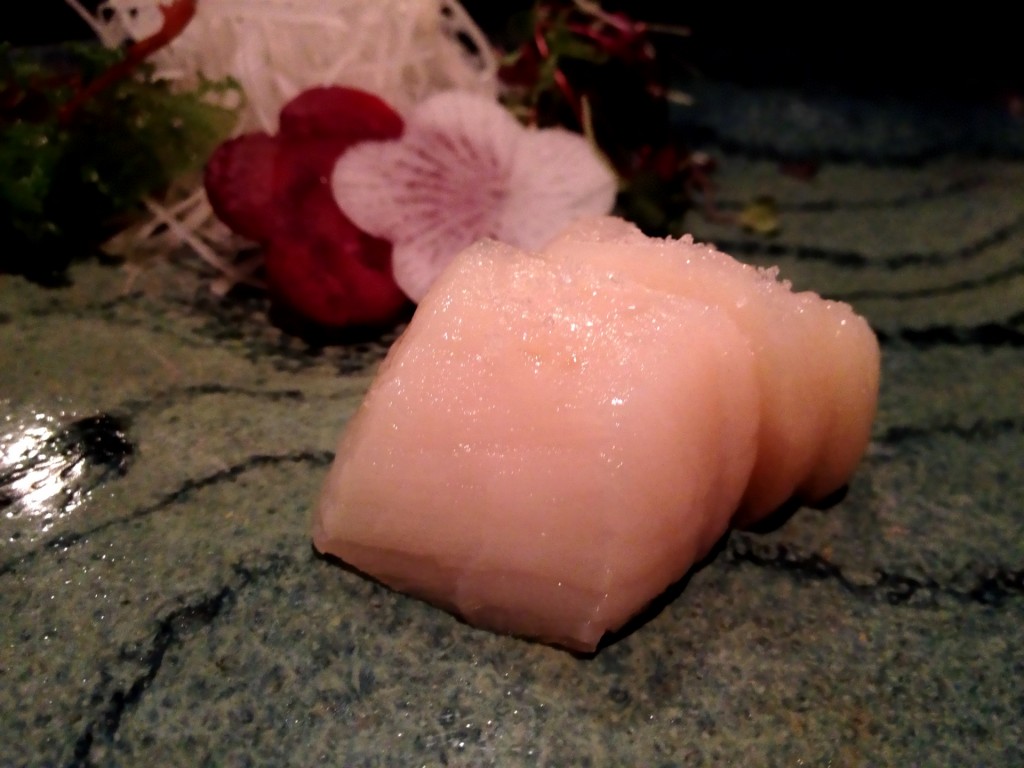
The last, but certainly not lease, of the sashimi course was hon maguro toro (fatty bluefin tuna). As expected, it had an unctuous, melt-in-your-mouth texture and wonderfully deep flavor.

From sashimi we moved to some more cooked courses, and Masa started by placing a beautiful, black, lidded bowl that resembled a miniature UFO.

Inside was suppon (snapping turtle) soup, something that I’ve never had before. From reading reviews, I knew that this course was a possibility, especially since I had specified that I had no dietary restrictions, but I was a little uncomfortable with the idea of eating turtle.
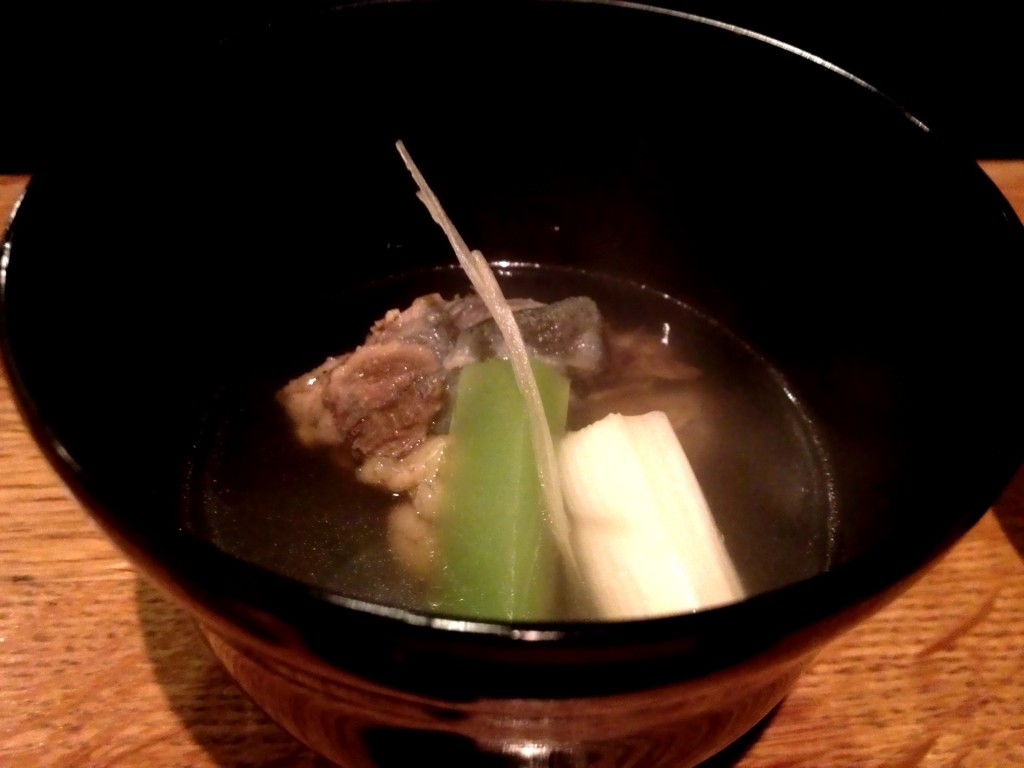
Having been served the dish, I did feel compelled to try it. It may sound cliched, but it tasted like chicken. I’ve had other things that are described in the same way (alligator, frog legs, snake) and none of those tasted particularly chicken-y to me, but the turtle really had nearly-identical taste and texture to chicken. Not something I need to order again, but I’m glad to have tried it.
Next was a favorite ingredient of my wife’s, fresh takenoko (bamboo shoots), roasted simply and served with tempura of butterbur blossom.

The bamboo had a slightly sweet smokiness to it, and the tempura butterbur blossom reminded me a little of the tempura zucchini blossoms I’ve had at Shunji.
Next, Masa placed another lidded bowl, much smaller than the suppon bowl and made of clay.

Inside was tanba no kuromame, black soybeans from the Tanba region of Japan, steamed for ten hours in a light syrup and topped with gold flake.

The beans were mildly sweet and very tender. Apparently this is a very special delicacy in Japan, with the beans costing up to $50 a pound. It was something I never had before, and something I’d probably never order on my own, which is why I so enjoy the omakase experience, because it exposes me to new dishes like these.
I saw Masa-san handling what looked like a piece of wood but turned out to be a solid hunk of dried bonito.
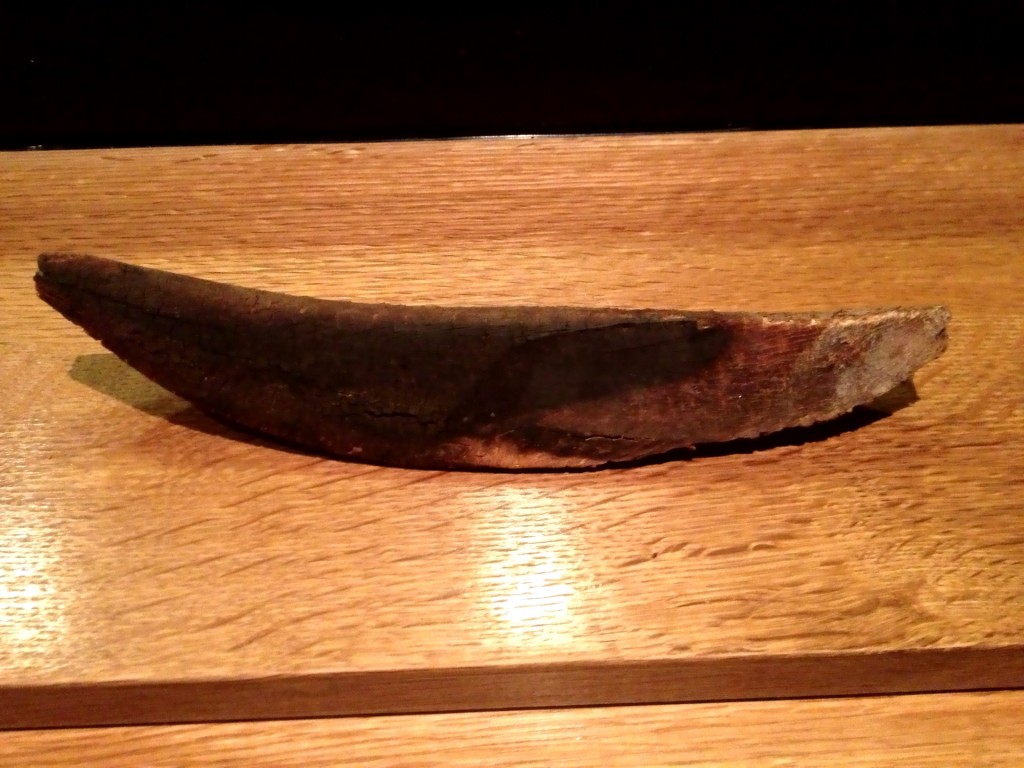
The bonito is grated onto many of the dishes being served, including the next one I had, kazunoko (herring roe) in sake.
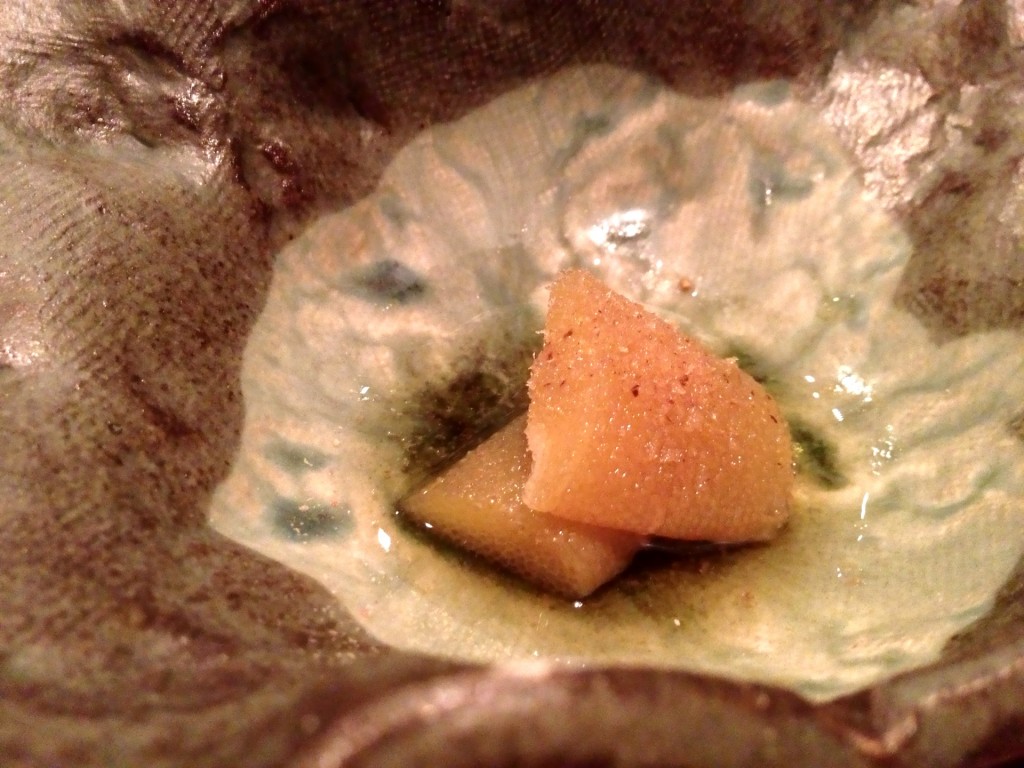
The roe was not overly salty, and the bonito added savoriness while the sake imparted a sweet astringency.
Next was a course I was very much looking forward to, tora-fugu (pufferfish or blowfish). Like the suppon course, I knew from reviews I’d read that a fugu course was likely during the omakase. While I had heard that fugu imported to the U.S. had to be free from the toxin (it’s all cleaned and prepared in Japan before arriving in the U.S.), I was still nervously excited to try the delicacy.

Rather than serving it as sushi or sashimi, Masa-san prefers to have the patron briefly cook the fugu on an ishiyaki stone. The flavor of the fugu is very mild and reminded me a little of sayori (needlefish), and the texture is a little chewy. The yukishio “snow” salt from Okinawa that was served with it help to season the fish a bit. Having had it now, I probably wouldn’t go out of my way to order it again, but, like the kuromame and suppon, I’m glad to have tried it.
The last dish before the sushi course was another mystery lidded container, this time made of stone.

Inside was a golf-ball size piece of fugu no shirako (milt), which was hot and creamy and smoky and unctuous, a rare treat!

While I savored this last bite of the cooked course, Masa-san began setting up for the sushi course, bringing out the lacquered boxes of fresh fish and arranging the instruments he would need to make the nigiri, including a beautiful wooden brush for the shoyu he would use.

Again Masa asked if I had any special requests or if I’d like to leave the sushi courses up to him. Again I acquiesced. He started with kohada, gizzard shad, which they called cured spotted sardine in English on their menu. It did not taste cured, but was a bit milder and not as bitter as the kohada I’d had before.

Next was uni (sea urchin) from Maine. I’ve tried uni from a variety of regions, including Santa Barbara, San Diego and Hokkaido, but I had never had uni from the East Coast. The lobes of “roe” (technically gonads) were smaller than the West Coast uni, and it had a more buttery and less briny taste.

Next was hon maguro akami (lean bluefin tuna) brushed with ponzu, presumably from the same fish that gave me the amazing toro sashimi I had earlier in the evening. The akami was definitely not as spectacular as the toro, but held its own.

Next was one of my favorite foods, ikura (salmon roe). Masa said the ikura was very fresh and unadulterated, not salted or marinated in any strong seasoning. It was probably the most subtle-tasting ikura I’ve had and I really appreciated the nuance of the flavors.
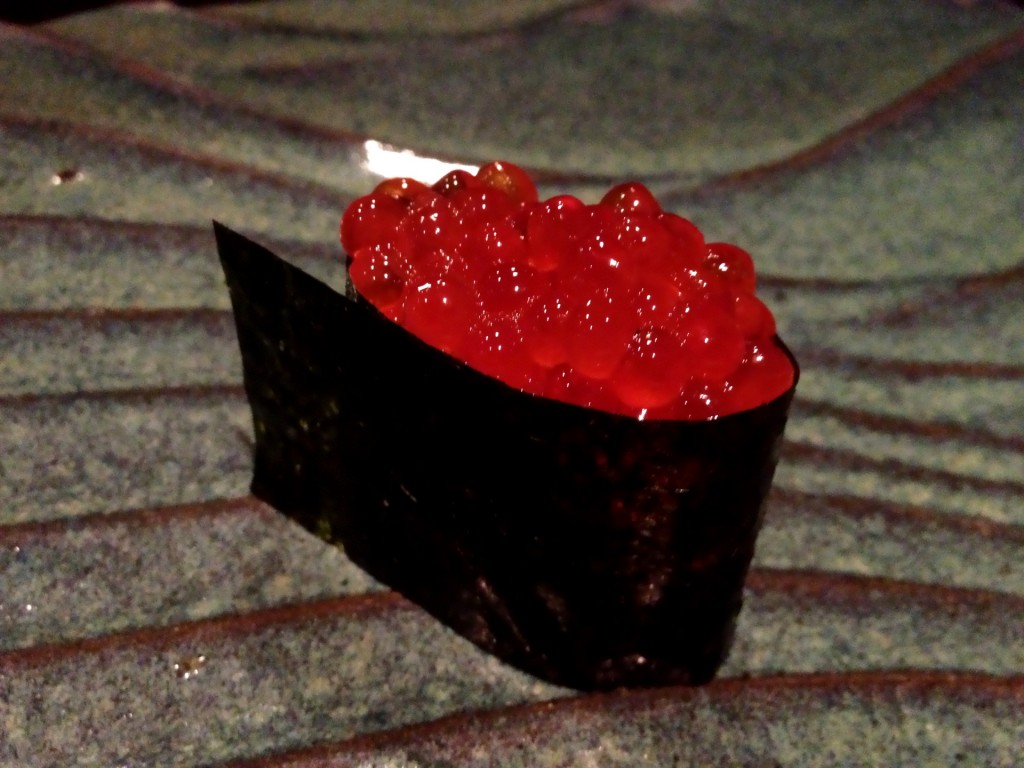
Next was tennen buri (premium wild yellowtail). Buri is the more mature stage of the wild yellowtail, while inada is the immature stage. Neither taste that similar to hamachi, the ubiquitous farmed yellowtail served in most sushi restaurants. The buri was very fatty and unctuous, almost like toro, and was delicious.

Next was suzuki (Japanese sea-perch or bass). Masa said suzuki is usually a summer fish, but this was a wild winter suzuki from Japan. It tasted extremely clean and fresh.
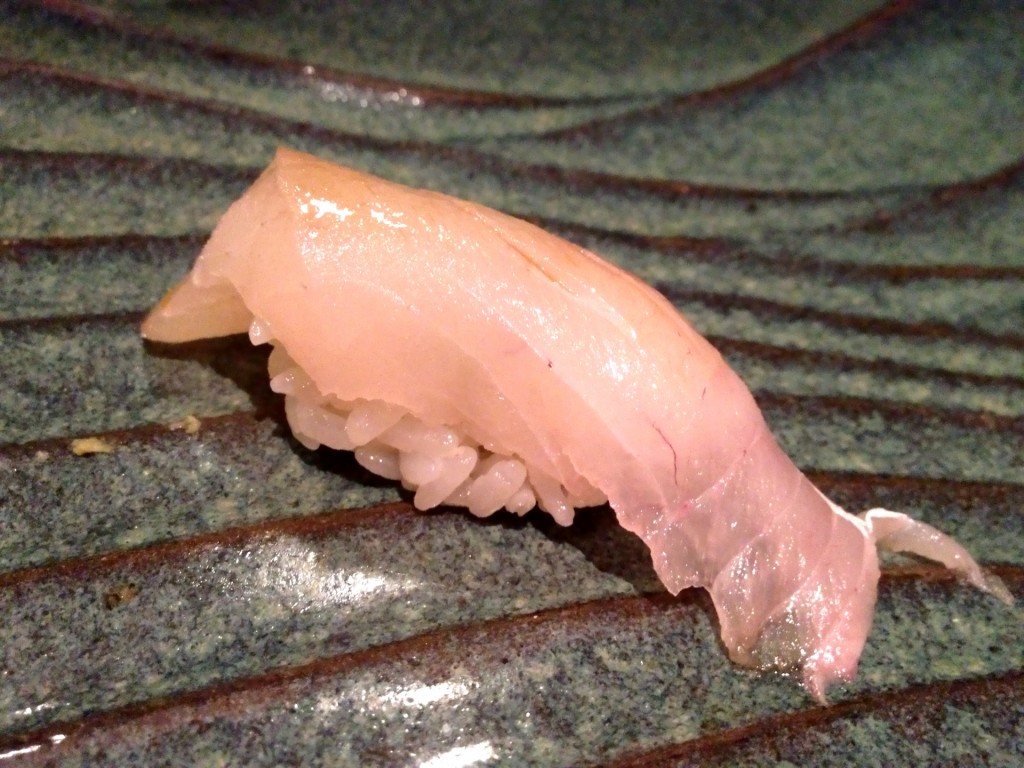
Next was hokkai masu (arctic char) from Iceland. Char is from the same family as salmon and its flesh has a similarly orange hue. The char I had was not as fatty as salmon and had a milder flavor.

At this point Masa asked if he should continue with a few more pieces of sushi or wind down to dessert. Not wanting to give in yet, I request two more pieces.
The penultimate nigiri that I had for my meal was kuruma ebi (wheel shrimp) from Madagascar, lightly grilled. The shrimp was smoky, briny, sweet, and plump, probably one of the best tasting cooked shrimp I’ve had.
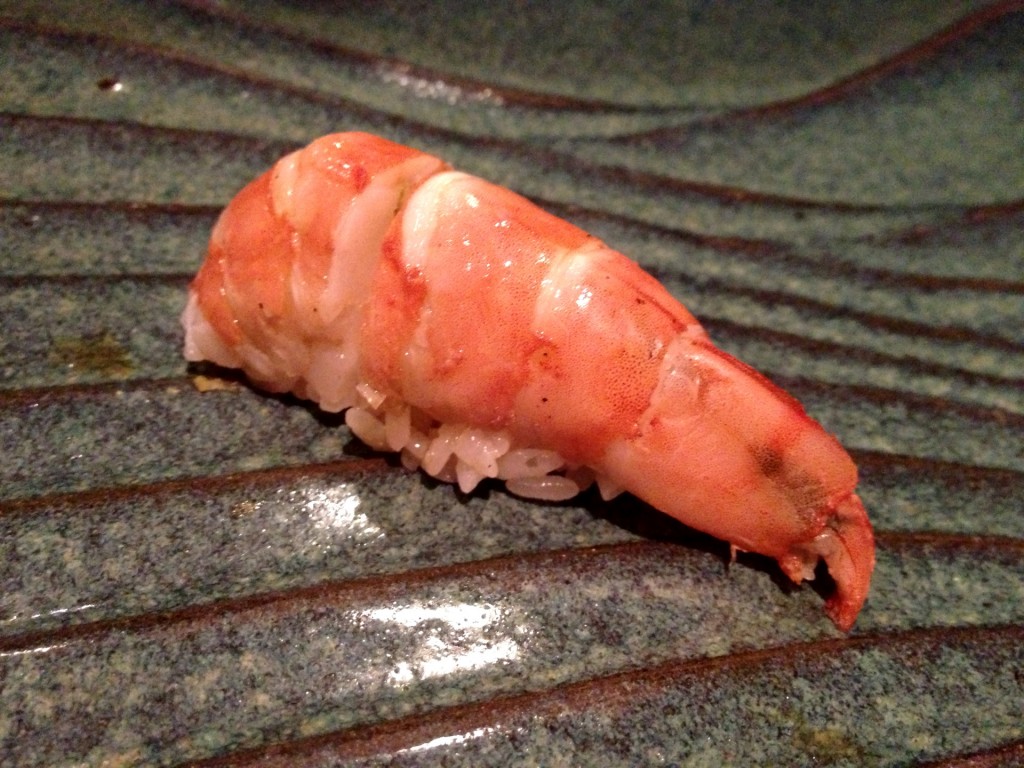
After pondering over what fish I should have as my final piece of sushi, Masa convinced me to try the saba (Atlantic mackerel). Saba is one of those fish that at mediocre restaurants taste like pickled fish from a jar or can. Masa assured me that the saba they had were amazingly fresh and just lightly marinated.
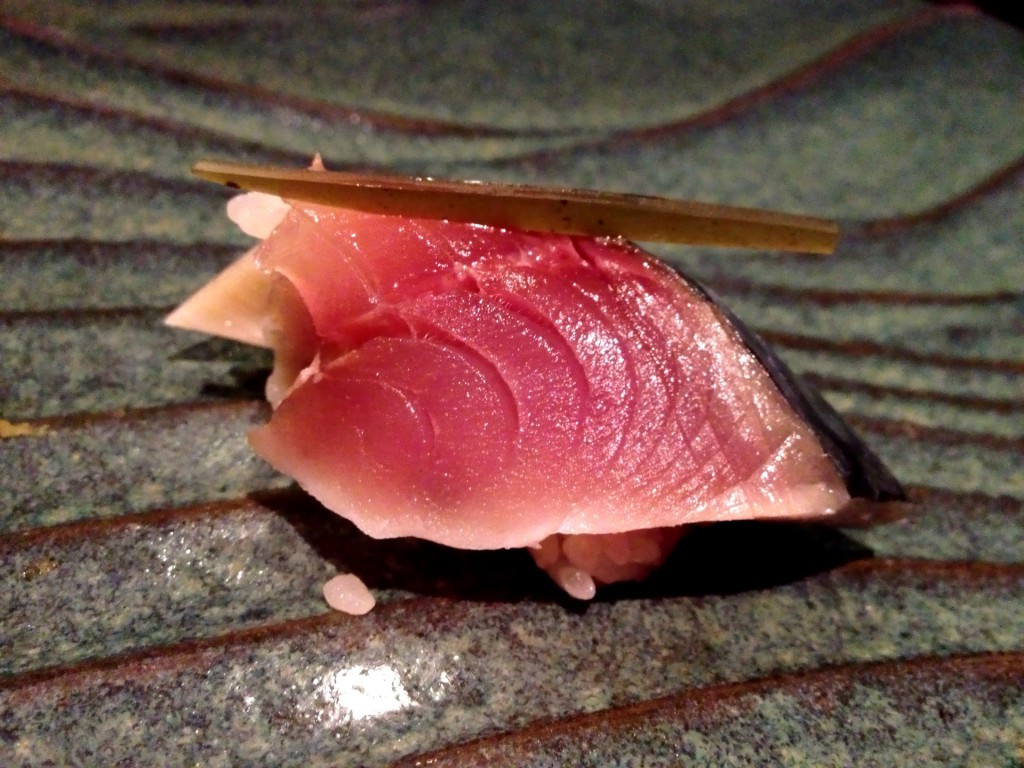
One look at the nigiri and I knew Masa was right. The light-colored tinge of marinated flesh only breached slightly into the the fish, leaving a bright reddish-pink center that I had never seen before in saba. The taste and texture were also unlike any saba I had before, rich and deep yet not overly fatty or oily, and not too firm or tough, an amazing way to end the meal.
Masa asked if I was interested in dessert. I’m not generally a sweets person, but everything else I had that evening was delicious, and I wanted to see what they could do with dessert. As someone who does like flan and panna cotta, I settled on the hojicha pudding. As I had hoped, it did remind me a great deal like panna cotta in texture. It did not have the strong “green tea” taste of matcha, rather it had an almost milk-tea-meets-mild-coffee flavor to it.

At this point I’m sure many of you are wondering how much my bill was, so I won’t keep you in suspense. Before tax and gratuity, the flight of three sake was $20 and the omakase was $160. Obviously an expensive meal, but if you consider the amount of food (~10 cooked dishes, ~8 sashimi, ~9 sushi, dessert), the rarity and quality of the ingredients, and the service and experience, it was absolutely worth it!
Were I to come back to D.C. again, of course I would like to try Kaz Sushi Bistro, but I would not hesitate to book a seat at the Omakase Counter at Sushi Taro again!
—–
Sushi Taro
1503 17th St NW
Washington, DC 20036
(202) 462-8999
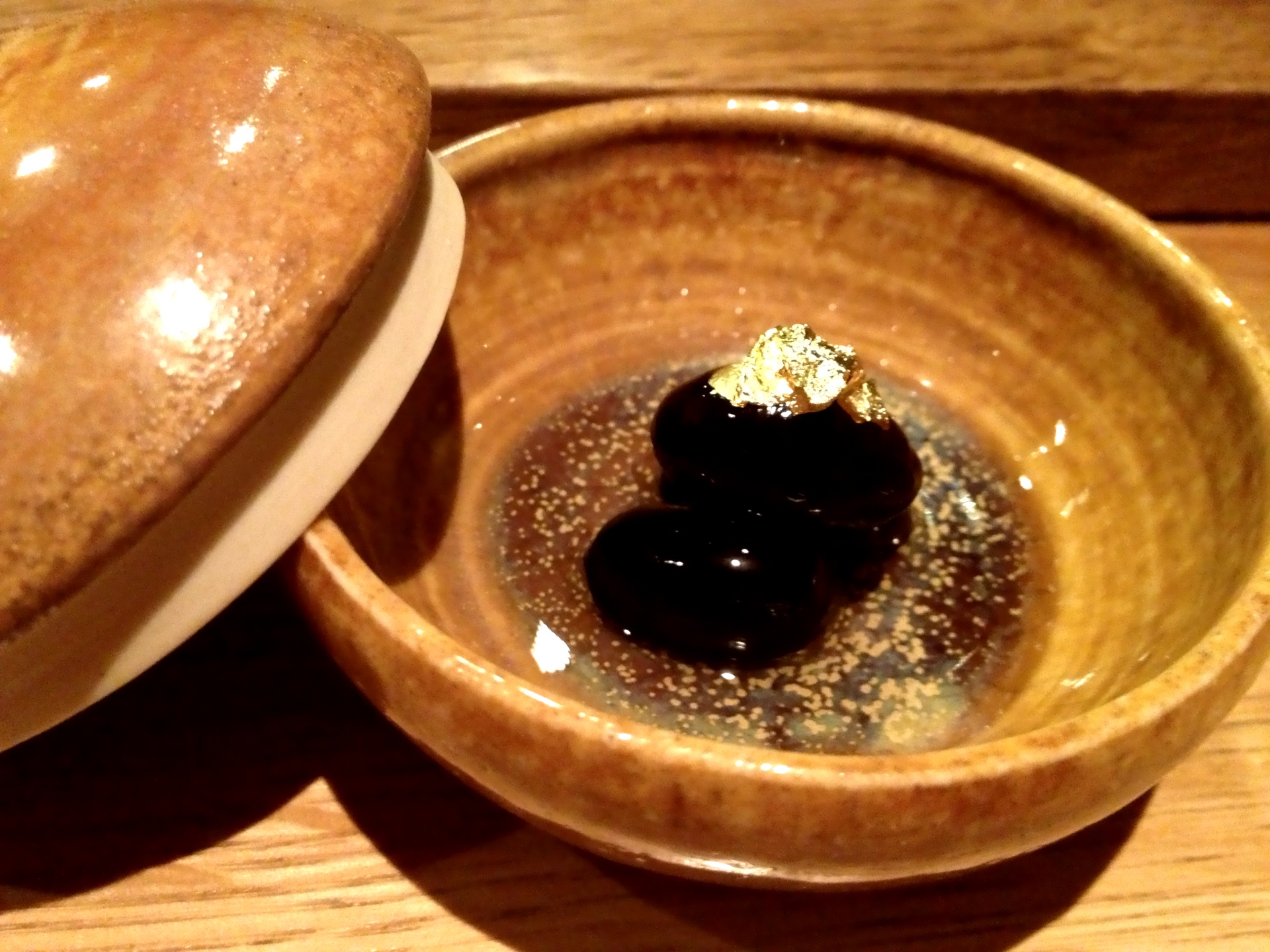
Leave a Reply